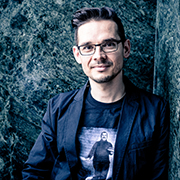Three questions to Miroslav Srnka
move 03 is the title of your new piece which will be premiered in Monte Carlo. In which form does motion play a role? How does it correspond with the sound?
Miroslav Srnka: The English word “move” stands for different meanings: it denotes a motion towards reaching another place or a goal, a specific dance motion, or the action of a figure in a game. For me “move” increasingly has two interpretations. The first interpretation lies in motion as structure: with musical means, for example with the form of a polyphonic swarm, an eventful, shimmering three-dimensional structure is suggested, which recalls bird flocks, for instance. The second interpretation relates to the motions of musicians, with which they physically produce sound.
Earlier, with moves 01 and 02 you spoke of this very physical conception, the fact that the musician’s playing motion is of relevance. What have you picked up on here?
I increasingly believe that the expression of an interpretation depends on a physical feeling and a physical freedom of the orchestral musicians, both individually and collectively. I want music to fly. In order to fly, the musicians need freedom. Their feeling of freedom comes from a free motion. And the free motion is conditional upon what is called “state of mind” in English, on its “poise”, a “flow”. This is expressed in the music most simply through a legato. A legato is the only way of thinking about phrasing which is really common to all instruments. Even percussionists think in legato. For that reason in my scores it acquires the basic status of a way of articulation. But it is not only a conventional legato. With the strings, for example, it is produced through a “molto arco”, through using as much bow as possible, even in pianissimo. Less use of the bow would produce less flying energy. However, I don’t want the music to land, but for it to fly away into the silent distance. For that reason, with a decrescendo the bowing motion is not reduced, but a fast bowing motion is used with decreasing pressure until the sound disappears through different flautando-like and less rich tonal colours within the energy of motion.
The work is part of a series of compositions – moves 01 and 02 were performed together. Do the “moves” form a cycle? How independent are they?
The series of moves (for orchestra) and the series of tracks (for small chamber scorings) are my internal niches at the moment to enable me to search for connections between my own pieces and to carry the consequences forward. From this, series are created which can be performed both separately and in sequence, or even in integral performances in different sequences. moves 01 and 02, for example, were premiered in reverse order.
Initially I started from a loose combination of pieces in the tradition of symphonic dances. “move” is also reminiscent of “movement” – the English name for a symphonic setting. Of the three existing moves, move 03 is closest to such a “movement”. It is the most independent of the three pieces, because it is also the most heterogeneous... It is also the first work which I wrote after the opera South Pole. The music after it had to be in accordance with it. Clear “white” objects flowed into the motion. They allow the motion to stop in sound-stases. As if you could hold up the music with a stop button and then observe the moment of a sound from several sides until you are ready to follow the flow further.
Questions by Marie Luise Maintz
(from [t]akte 1/2017)



